Detailing and Conservation of Vernacular Slate and Stone Roofs
Terry Hughes
 |
|
Figure 1 Because it was carefully recorded before
dismantling, it was possible to
reconstruct this Pembrokeshire cowshed with all its original
detailing. |
Presented with a roof like the one shown in Figure 1, owners and contractors often strip it and dump it in the nearest skip. More than the loss of a historic roof, this represents a missed opportunity. Buildings like this which have been neglected or poorly maintained can provide valuable (and increasingly rare) information about historic roof construction.
Although we may disparage Turnerising (covering the roof with mesh and bitumen) as the ruination of a good roof, and even be a bit sniffy about grouted roofs (which are covered with mortar) in spite of their contribution to landscapes, they are flies in amber: they preserve the slating for recording and authentic reconstruction more or less as constructed.
Happily the Pembrokeshire cowshed roof shown in Figure 1 has benefited from the care of a conservation-minded owner and a sympathetic contractor. The outcome has seen the roof conserved while the process has also advanced our knowledge of vernacular detailing and provided training for tomorrow’s slaters.
RECORDING ROOFS
 |
|
| Figure 2 To understand an old roof’s construction, the surveyor must first understand how slating works. Water penetration is prevented by having adequate laps between slates but in some traditions additional precautions such as placing small pieces of slate or shales over the slates’ heads are used to keep out water. | |
 |
|
| Figure 3 Where the slating has become displaced it is possible to digitally ‘reconstruct’ the original arrangement. Slates 21, 22, 23, 24 have slipped off their laths. | |
 |
|
| Figure 4 Slipped slates digitally repositioned onto their laths to show the original triple lap construction – course 21 overlaps slate course 24, etc. |
Any intervention in a roof should start with an understanding of the existing roof. This can be very difficult because the slating may have deteriorated to the point where the original construction is completely hidden or where movement in the structure might mask an inherent flaw in the construction. It isn’t always clear whether a lath failure has resulted in slates slipping, or the slates slipped first causing the laths to rot.
For these reasons and because he or she will recognise any special details as they are exposed, the person doing the work must thoroughly understand how slating works (Figure 2). If the roof has deteriorated substantially, if for example the laths and slates have moved, the best option may be to try to establish the original slater’s intention when the roof was laid rather than what is there now. Photographs taken perpendicular to the slope and including a scale and course numbers will show the present condition. By manipulating the image it is also possible to work out the original detail (Figures 3 and 4).
The reason for the survey is probably that the roof needs attention but it is important to give the surveyor a clear explanation of what is required. It is a much bigger job to produce a detailed description of a roof and its importance than to decide whether it is beyond repair and maintenance. In practice, it is rare for a formal survey to be requested until the roof is beyond repair and needs stripping and re-laying, so besides recording the present condition and the original detailing it will be vital to decide whether any changes are needed.
Leaving aside the issues of installing underlays or insulation and ventilation, the key question is whether the roof was weather-tight as originally constructed and whether the same specification will be satisfactory for the future. This will require experience and judgment on the part of the surveyor and specifier and was a good deal easier to determine before our BS/EN codes of practice began to anticipate an increase in the frequency and intensity of deluge rain.
RECORDING TECHNICAL DETAILS
The survey should record all the materials used and the constructional details. For a modestly sized building this can be accomplished in a day provided there is not too much variation in the roof slopes. Access with roof ladders from a parapet, horizontal valley or a scaffold tower is normally adequate and it is wise to have a roofer in attendance to help with handling slates and to reinstate work without delaying the survey. It is possible to use a cherry picker but work is much slower and the lack of space on the platform can be a problem.
Forms to help with recording are included in the English Heritage Technical Advice Note Stone Slate Roofing (see Recommended Reading) but making written notes is not easy on a roof ladder and the best option is voice recording. A methodical approach is essential. When recording head and side laps, lath or batten gauges and specific details about perhaps 50 courses it is very easy to get lost. A consistent format such as ‘Head lap three inches, course six over four’ will avoid errors. Every course should be photographed, ideally showing three or four courses raked back. If the recording does go wrong the photographs will usually save the day. Besides the arrangement of the slates the roof pitch should be measured for each slope and the constructional details at the eaves, valleys, ridge, hips and abutments examined.
Finally, the type of mortar and the way in which it has been used should be checked. Externally, this can be as spot-bedding or tail-bedding with or without the mortar carried up the perpendicular joints and internally as head-bedding or torching (Diagram 1). It is important to distinguish between original tail-bedding and pointing carried out later, often to prevent drafts, and to check whether there is continuity between exterior and interior mortar which will have drawn moisture to the laths. External grouting and slurrying is almost always a repair to try to save a failing roof.
 |
 |
||
| Figure 8 Wrestler ridge removed from a roof in Pembrokeshire. In this region the top of the slates is filled with mortar | |||
 |
|||
| Figure 5 Mortar is used in traditional slating to
improve wind resistance, to help slates to sit well
together without gaps and to prevent draughts. KEY
A, spot bedding; B & C, tail bedding without and
with the perpendicular joints included; D, head bedding; E, full torching; F, half torching. |
|||
 |
Figure 9 Crow steps set into a gable wall as a damp course and to throw water onto the roof away from the vulnerable slate abutment. This example is in Mid Wales | ||
| Figure 6 In the UK there are three basic lapping systems and some minor variations. Double lap is the most common but single and triple are important vernacular methods and should not be substituted by double lap when a roof is renewed. |  |
||
 |
|||
| Figure 10 Slating which is only carried half-way onto the gable wall will have always leaked so it is difficult to understand why it is so common. This crude attempt to seal the junction is in Mid-Wales. It is speculated that the slating has replaced a thatch roof where the raised abutment would have secured the thatch as in Figure 13 | |||
| Figure 7 A ‘cussome’ eaves detail | |||
VERNACULAR DETAILS
There are two aspects to the vernacular detailing of roofs: the lapping system employed and the way intersections are constructed. Although these are regional in character they can be similar to roofs in distant places and may reveal a continuity of craft skill over hundreds of years and thousands of miles.
Broadly there are three slate-lapping systems encountered in Britain: single, double and triple lap (Figure 6), with some variations. There are also variations for single size (tally) and random size slates and between slates and stone slates. Double lap tally slating is the most familiar system and accounts for the majority of roofs and needs little explanation. All the manufacturers can supply details for this system.
Single lap exists in the far north of Scotland and close to quarries elsewhere. It uses very large slates which wouldn’t have survived transport over long distances. It has links with techniques seen in Norway and Sweden and was also ‘invented’ by Charles Rawlinson of Lostwithiel, patented in 1772, promoted by James Wyatt and adopted for many prominent buildings (including the Reform Club, London, Charles Barry, 1841, and Penoyre House, Brecon, Anthony Salvin, 1848) and most notably as a modular system on cast-iron frame buildings such as the Church of St Michael in the Hamlet, Aigburth, Liverpool. Single lapping is also used for Horsham stone-slating but with smaller slates.
Triple lap is best known from Devon and Cornwall where it is principally used in very exposed locations, although one example is known from North Wales which may be the last remaining example here. It can be used with or without mortar bedding. Each of these systems has distinctive ways of dealing with intersections such as valleys.
Before lead was adopted as the solution to intersections on roofs, slaters used their skill and ingenuity to devise watertight details using the slates or stones. The effort and effectiveness was proportional to the exposure of the detail so valleys, which carry more water, were more complex and effective than ridges and hips, which carry little.
There is little variety in eaves construction. The main variation being how far they overhang the wall, this being larger where there are no gutters and water needs to be cast well away from the wall. With heavy materials such as Cotswold stone slates this has necessitated the ‘cussome’ detail (Figure 7) in which the eaves slates are set under the first lath to prevent them tilting over.
 |
 |
||
| Figure 11 Carrying the slates over the outer face of the gable and bedding on a stone cope secures the slates but also avoids leaks. | Figure 12 A thatched verge abutment at St Fagans National History Museum, Cardiff | ||
 |
 |
||
| Figure 13 Slaters used great ingenuity to devise effective valleys without using lead. This mitred example in Denbighshire which uses slate ‘soakers’ was described as a common method by Hughes and North (The Old Cottages of Snowdonia, 1908) but they have now almost completely disappeared. | |||
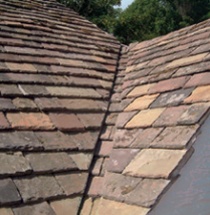 |
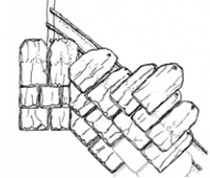 |
||
| Figure 14 The Welsh valley is common throughout Mid Wales and the Marches in metamorphic slates and stones. It is lined with courses of the same material which may be open or more rarely close mitred (Figure 15). | |||
 |
 |
||
| Figure 15 A close-mitred Welsh valley in Denbighshire. The main slates have been removed in the upper courses to expose the lining slates. This is thought to be a rare detail but as it can only be confirmed by opening the valley there may be more undiscovered examples. | |||
Ridges were often constructed using slates rather than ridge tiles or stone. They either simply overlap from the windward side onto the leeward side or are interlocked and known as ‘wrestlers’ (Figure 8). On older hips the slates are simply mitred together and bedded in clay, mortar or mastic.
At abutments with walls the technique is to try to direct water away from the vulnerable junction. One solution is to build the wall with stones projecting out over the junction, either neatly following the line of the roof or as ‘crow steps’ which cast water onto the main slope (Figure 9), and by tilting up the slating by raising the last rafter. The junction would then be covered with mortar often with a further line of slates or ‘listings’ bedded on. Interestingly, on the Pembrokeshire roof shown in Figure 1 the abutment was found to have an open channel formed with slates under the mortar. Abutments with verge copings apply similar methods. But it is surprising that some verges were formed with the outer leaf of the wall carried up above the slating introducing a vulnerable joint (Figure 10). Protecting the slates from wind-lift is obviously a factor but it could be provided by bedding copings onto slating carried through to the outer face of the wall (Figure 11). This may be a detail unaltered from a previous thatch roof (Figure 12).
Valleys have two basic forms: the slates or stones are carried around the junction in their courses, or the slates form a lining similar to a lead valley (Figures 13 to 20). The latter can be open- or close-mitred. These are very prominent on a roof and should always be re-instated when re-slating.
VERNACULAR MATERIALS
The materials that should be conserved when repairing roofs include laths, fixings (pegs or nails), mortar and the slates or stones slates. Only where there is a good technical reason should a different material be adopted. For example, for durability copper nails are preferred to iron, but there is no technical reason to replace riven laths with sawn battens. For health and safety reasons, 50 x 25mm battens are accepted as a safe working platform but riven laths can be acceptable if sensible precautions are taken. For a roof that has performed satisfactorily in the past without an underlay there is probably no reason to include one when the roof is reinstated. In particular it should be remembered that a roof without an underlay has a better vapour permeability than one with a vapour permeable membrane.
The greatest difficulty in roof conservation is obtaining authentic slates or stone slates. This topic has been discussed extensively elsewhere and is far too wide-ranging to address here. Suffice it to say, many slates and stones are still available (Hughes, 2008; Emerton, 2000) and there is a protocol for deciding what to use as a substitute where the original is out of production (Hughes, 2009). When trying to source roofing slates or stones, claims of unavailability made by importers and roofers should always be checked with the source quarry. For anything out of the ordinary it is essential to draw up a product specification with the quarry. Failure to do so may result in a radical difference of appearance in the finished roof or laying problems during construction.
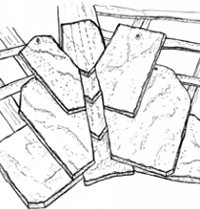 |
 |
||
| Figure 16 The Pennine chevron valley differs from the Welsh in having single stone slates laid as a lining and cut to sit against the main slates on either side. | Figure 17 The West Country collar and tie uses very narrow slates in the valley but it works because the slating is triple lapped. A similar valley is known from Pembrokeshire. | ||
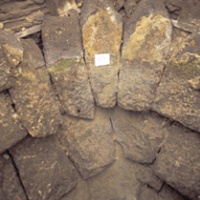 |
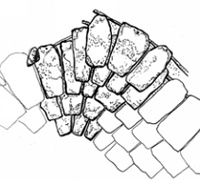 |
||
| Figure 18 The distinctive Cotswold swept valley carries tapered slates across the courses. | |||
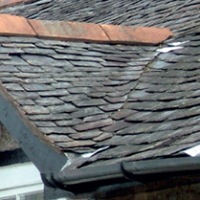 |
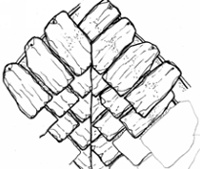 |
||
| Figure 19 Half-swept valleys are common in Wales especially on dormers where the slating is swept across from the main slope and underneath a raking cut. | |||
 |
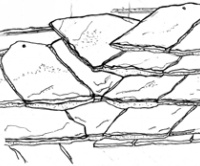 |
||
| Figure 20 Laced valleys where the stone slates are turned up to fit against a lozenge shaped slate in the valley are always used for Collyweston slating. | |||
THE FUTURE OF ROOF CONSERVATION
The 20th century saw many regrettable developments in roofing. New materials were adopted which often proved to be detrimental. Specifications for re-slating often included default details such as lead valleys because it was assumed that the vernacular detail was inadequate or slaters have been left to make their own poorly informed decisions on what was appropriate.
Happily this is changing. Guidance on vernacular roofing is being published increasingly regularly, training is being provided for slaters, and an accreditation scheme for roofers which includes the principles of conservation is being run by the National Federation of Roofing Contractors. Those responsible for maintaining historic buildings (especially main contractors with an eye to keeping to programme above all else) now need to take advantage of these initiatives and recognise that good work costs more and shouldn’t be rushed. They should also recognise that high quality work pays off in the long run. Of all the things that have resulted in problems for re-slated roofs, the culture of accepting the cheapest tender has been the greatest culprit.
~~~
RECOMMENDED READING
F Bennett and A Pinion, Roof Slating and Tiling, Donhead, Shaftesbury, 2000
G Emerton, The Pattern of Scottish Roofing, Historic Scotland, Edinburgh, 2000
English Heritage, Practical Building Conservation: Roofing, Ashgate, Farnham, 2013
English Heritage, Stone Slate Roofing, Technical Advice Note, 2005
TG Hughes, ‘Vernacular Slate and Stone Roofs in England’ in England’s Heritage in Stone, English Stone Forum, Folkestone, 2008
TG Hughes, ‘Sourcing Roofing Slates’, The Building Conservation Directory, Cathedral Communications, Tisbury, 2009
The Society for the Protection of Ancient Buildings, SPAB Regional Advice Note 2: Slating in South West England
Stone Roofing Association, Horsham Stone Roofs, 2009
Stone Roofing Association, Glossary of Stone Slate Roofing, 2010



